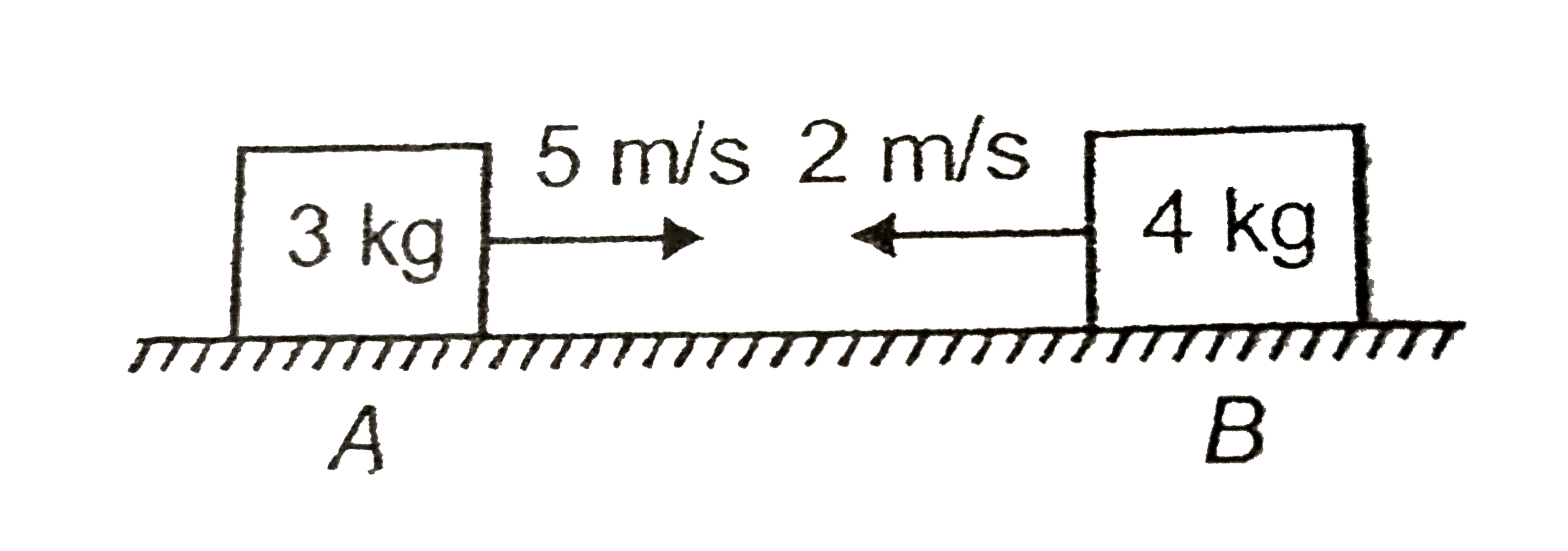Two bodies, each having a mass of 3kg, collide with each other. One body was at rest and the other was moving with a 4m⋅s−1 velocity. After collision they combine with each other. Find out the heat produced as a result of this collision. Mechanical equivalent of heat = 4.2J⋅cal−1.Solution in Bengali
The correct Answer is:2.86 cal
Step by step video, text & image solution for Two bodies, each having a mass of 3kg, collide with each other. One body was at rest and the other was moving with a 4 m cdot s^(-1) velocity. After collision they combine with each other. Find out the heat produced as a result of this collision. Mechanical equivalent of heat = 4.2 J cdot cal^(-1). by Physics experts to help you in doubts & scoring excellent marks in Class 11 exams.
Updated on:21/07/2023Topper's Solved these Questions
- FIRST AND SECOND LAW OF THERMODYNAMICSBOOK - CHHAYA PUBLICATIONCHAPTER - FIRST AND SECOND LAW OF THERMODYNAMICSEXERCISE - Entrance Corner - Assertion-reason type
4 Videos
- FIRST AND SECOND LAW OF THERMODYNAMICSBOOK - CHHAYA PUBLICATIONCHAPTER - FIRST AND SECOND LAW OF THERMODYNAMICSEXERCISE - Entrance Corner - Multiple correct answer type
1 Video
- FIRST AND SECOND LAW OF THERMODYNAMICSBOOK - CHHAYA PUBLICATIONCHAPTER - FIRST AND SECOND LAW OF THERMODYNAMICSEXERCISE - Exercise - Problem Set - II (Marks 3 or 4)
33 Videos
- EXPANSION OF SOLIDS AND LIQUIDSBOOK - CHHAYA PUBLICATIONCHAPTER - EXPANSION OF SOLIDS AND LIQUIDSEXERCISE - CBSE SCANNER
2 Videos
- FRICTION BOOK - CHHAYA PUBLICATIONCHAPTER - FRICTION EXERCISE - CBSE SCANNER
7 Videos
Similar Questions
Statement I : In an isothermal process the whole heat energy supplied to the body is converted into internal energy.
Statement II : According to the first law of thermodynamics ΔQ=ΔU+pΔV.
View SolutionCvandCp denote the molar specific heat capacities of a gas at constant volume and constant volume and constant pressure, respectively. Then,
View SolutionThe temperature of a hailstone is 0∘C and initially it is at rest. When it falls from a height, 160the part of it melts. Calculate the height, Ignore the air resistance and assume that the temperature of the surroundings is 0∘C. When it hits the ground, only 15th of its stored energy is converted into heat.
View SolutionShow that the coefficient of superficial expansion of a rectangular sheet of the solid is twice its coefficient of linear expansion.
View SolutionDefine angle of friction. The inclination θ of a rough plane is increased gradually. The ply on the plane just comes into motion when inclination θ becomes 30∘. Find coefficient of friction. If the inclination is further increased to 45∘ then find acceleration of the body along the plane. (g = 10 m.s−2)
View SolutionA body of mass m makes an elastic collision with another identical body at rest. Show that if the collisionis not head on the bodiese to at right to each other after the collision.
View SolutionTwo bodies move towards each other and collide inelastically. The velocity of the first body is 2 m//s and that of the seconf is 4m//sec before impact. The common velocity after collision is 1 m//s in the direction of the first body. The number of times did the KE of the first body exceed that of the second body before collision.
View SolutionTwo bodies of mass m_(1) = 1kg and m_(2) = 2kg move towards each other in mutually perpendicular directions at velocities v_(1) = 3m//s and v_(2) = 2m//s (Fig). As a result of collision, the bodies stick together. Determine the amount of heat Q liberated as a result of collisions.
View SolutionTwo bodies of masses 0.1 kg and 0.4 kg move towards each other with the velocities 1 m/s and 0.1 m/s respectively, After collision they stick together. In 10 sec the combined mass travels
View SolutionTwo particles A and B of mass 3kg and 4kg moving on a smooth horizontal surface with speed 5m/s and 2m/s respectively collides each other. Coefficient of restitution is e=12, then

Velocity of B after collision
View SolutionTwo balls are moving towards each other on a vertical line collides with each other as shown. Find their velocities just after collision.
View SolutionA body (A) of mass 100 g and another body (B) of mass 400 g approach each other with velocities of 100 cm⋅s−1and10cm⋅s−1 respectively. After a head on collision, the bodies coalesce. After collision, find the displacement of the combined mass in 10 s .
View SolutionTwo particles of equal mass moving towards each other with velocities 20 m*s^(-1) and 30 m*s^(-1) collide. If the collision is elastic, find their velocities after the collision.
View SolutionTwo bodies of masses 5 kg and 10 kg move towards each other with velocities 10m⋅s−1and14m⋅s−1 respectively. If the coefficient of restitution is 0.8, find their velocities after the collision.
View SolutionA body of mass 2 kg is pulled with a velocity 2m⋅s−1 on horizontal surface. What will be the heat produced in 5s, if the coefficient of friction between the body and the surface is 0.2? Given, J=4.2J⋅cal−1,g=9.8m⋅s−2.
View Solution

